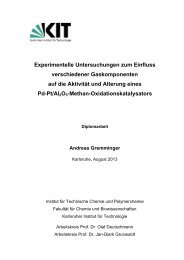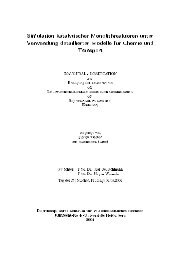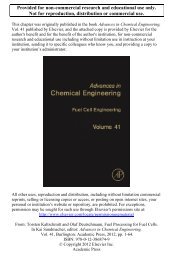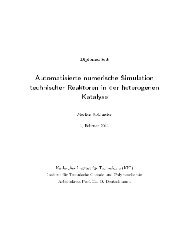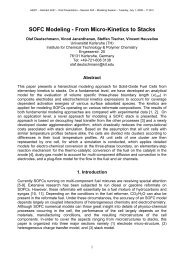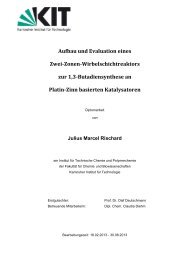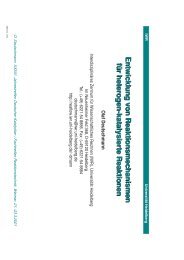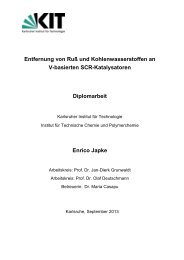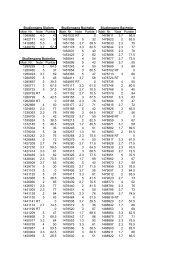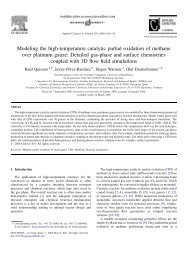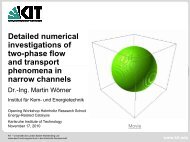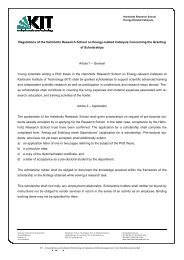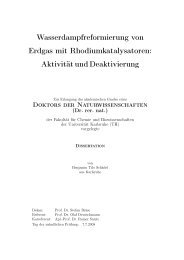Tutorial Modeling of monolith reactors
Tutorial Modeling of monolith reactors
Tutorial Modeling of monolith reactors
Create successful ePaper yourself
Turn your PDF publications into a flip-book with our unique Google optimized e-Paper software.
Introduction to Monolith<br />
Reactor Modelling:<br />
Mass, Energy and Momentum Transport<br />
R.E. Hayes<br />
Department <strong>of</strong> Chemical and Materials<br />
Engineering, University <strong>of</strong> Alberta,<br />
Edmonton, Alberta, Canada<br />
MODEGAT 14-15 September 2009<br />
1
Objectives <strong>of</strong> this presentation<br />
• To give an introductory overview to the<br />
area <strong>of</strong> <strong>monolith</strong> reactor modelling<br />
• To high light some <strong>of</strong> the factors that<br />
must be taken into consideration when<br />
choosing a model.<br />
2
Why use computer modelling?<br />
• Experiments are expensive and take time.<br />
• Analysis <strong>of</strong> <strong>reactors</strong> can be difficult, especially for<br />
fast highly exothermic reactions. Non-intrusive<br />
measurement methods may not be available.<br />
• Modelling can eliminate scenarios that do not<br />
<strong>of</strong>fer promise.<br />
• Faster design and optimisation.<br />
Models are not intended to eliminate experiments completely.<br />
3
Typical catalytic converter<br />
•The The catalytic converter uses a metal or ceramic <strong>monolith</strong><br />
support structure.<br />
•Typical Typical automotive converters use 400 CPSI cell density<br />
Hayes and Kolaczkowski, Chem.<br />
Eng. Sci., 49, 3587, 1994.<br />
Heck and Farrauto, Catalytic Air<br />
Pollution Control, 2002<br />
4
Observations<br />
• The problem involves the transport <strong>of</strong> mass, energy<br />
and momentum. It is a multi-physics<br />
problem.<br />
• Transport occurs at different scales in space.<br />
• The transient response <strong>of</strong> the gas phase and solid<br />
phase occurs at different time scales.<br />
• Modelling <strong>of</strong> <strong>monolith</strong> <strong>reactors</strong> is thus an exercise in<br />
multi-scale modelling.<br />
The <strong>monolith</strong> reactor presents a challenging modelling problem.<br />
5
Heterogeneous catalytic reactions<br />
Heterogeneous gas phase catalytic reactions typically comprise the same steps.<br />
Fluid flow over the solid results in a<br />
boundary layer through which heat and<br />
mass diffuse to the gas/solid interface.<br />
Reactants diffuse into the porous<br />
catalyst.<br />
External<br />
catalyst<br />
surface<br />
catalyst<br />
pore<br />
Bulk gas<br />
Reactants adsorb on the active sites.<br />
The reaction occurs on the active sites,<br />
located on the walls <strong>of</strong> the tortuous pores.<br />
Products desorb and diffuse back to the<br />
surface, and then through the boundary<br />
layer to the bulk fluid.<br />
6
Model Scales<br />
Micro scale: At the atomic/molecular level, the basic chemistry<br />
involves a set <strong>of</strong> adsorption/desorption and surface reaction<br />
steps. The genuine mechanism may be very complicated.<br />
Gas Phase<br />
Catalyst<br />
Meso scale: Single channel <strong>of</strong> a <strong>monolith</strong>. Includes gas<br />
phase flow, transport to the surface <strong>of</strong> the washcoat by<br />
diffusion, diffusion and reaction in the washcoat. The<br />
basic process in a heterogeneous catalytic reaction are<br />
present at the meso scale.<br />
Macro scale: Entire catalytic converter, which<br />
includes transport and interaction among channels.<br />
7
Model complexity: Points to note<br />
• How much complexity is wanted and or needed?<br />
– At what level do you wish to model?<br />
– How much information do you want to include?<br />
– Do you need to include all <strong>of</strong> the scales?<br />
• The model should be as simple as possible, but not<br />
simpler (Albert Einstein).<br />
• Models do not have to be perfect to be useful.<br />
Gas Phase<br />
Catalyst<br />
8
Mathematical formulation<br />
• The fundamental model is represented by a set <strong>of</strong><br />
equations, which include key assumptions<br />
– Algebraic equations, linear or non-linear<br />
– Ordinary differential equations (IVP or BVP)<br />
– Partial differential equations<br />
• Practical <strong>monolith</strong> modelling problems do not have<br />
analytical solutions; models are solved numerically.<br />
• The model selected and the way it is represented will<br />
determine the numerical method used for its solution.<br />
9
Mathematical formulation<br />
• Reactors are fundamentally distributed parameter<br />
systems ; Concentration, temperature and velocity<br />
vary with spatial coordinate.<br />
• The dimensionality (and hence complexity) can be<br />
reduced by using average parameter values over<br />
specified model dimensions. The result is referred<br />
to as a lumped parameter model.<br />
• Lumped parameter models are approximations.<br />
10
Basic models in common use<br />
• Single channel <strong>of</strong> <strong>monolith</strong> structure<br />
– 1D, 2D or 3D<br />
– Diffusion in the washcoat may be considered<br />
• Whole reactor with variable channel conditions<br />
and channel interactions<br />
– 2D or 3D , several model options exist<br />
– The upstream and downstream duct work might<br />
be included<br />
11
Single channel model (SCM)<br />
• Single channel <strong>of</strong> <strong>monolith</strong> structure<br />
• For a radially uniform <strong>monolith</strong>, the SCM is<br />
representative <strong>of</strong> the whole reactor<br />
• There are many approaches to writing a single<br />
channel model:<br />
– PDE models (all 2D and 3D models, some 1D)<br />
– ODE models (some 1D models)<br />
– Algebraic equations only (some 1D models)<br />
12
The 3D SCM<br />
• The real <strong>monolith</strong> does not have<br />
axial symmetry.<br />
• The washcoat can have a variety<br />
<strong>of</strong> possible shapes.<br />
• 3D is required for exact channel<br />
representation<br />
13
The 3D SCM<br />
• A minimum <strong>of</strong> a one-eighth<br />
section must be considered.<br />
• For complex shapes such as the<br />
“sinusoidal” channel, the entire<br />
cross section must be<br />
considered.<br />
• There is no analytical solution<br />
for the velocity.<br />
• Must solve the transport<br />
equations in three dimensions.<br />
14
The 2D approximate SCM<br />
• The 2D model approximates the<br />
channel as a right circular cylinder<br />
with a uniform annular washcoat<br />
layer, thus giving axi-symmetry.<br />
• The flow area, washcoat area and<br />
substrate area should be the same<br />
for each system.<br />
• The 2D model is still the most<br />
complex model that is used<br />
routinely.<br />
• The fully developed flow field can<br />
be approximated, thus reducing the<br />
number <strong>of</strong> equations to solve.<br />
15
2D and 3D SCM<br />
• 2D and 3D SCM are both distributed parameter<br />
models.<br />
• Temperature, concentrations and velocities vary with<br />
both axial (flow direction) and radial (transverse to<br />
flow) directions.<br />
• The most general model requires the solution <strong>of</strong> a set<br />
<strong>of</strong> coupled non-linear partial differential equations.<br />
• The equations are the same in each case – only the<br />
number <strong>of</strong> space dimensions changes.<br />
16
The 2D SCM<br />
• All <strong>of</strong> the physical/chemical processes present<br />
in 2D and 3D can be illustrated using a two<br />
dimensional model.<br />
Mass Transfer<br />
Direction <strong>of</strong> flow<br />
Heat Transfer<br />
Convection Radiation<br />
washcoat Diffusion and reaction Conduction<br />
substrate<br />
Conduction<br />
Centreline <strong>of</strong> wall<br />
17
Basic solution procedure<br />
• Each physical space (fluid, washcoat and substrate)<br />
is a computational domain governed by the<br />
conservation equations.<br />
• Write the governing differential equations for each<br />
domain (fluid, washcoat and substrate)<br />
• Often only the solid state energy balance equations<br />
retain the transient terms, owing to the relative<br />
magnitude <strong>of</strong> the time scales for fluid and solid.<br />
18
Modelling the fluid domain<br />
Velocity and pressure are obtained from the Navier-Stokes equation<br />
and the equation <strong>of</strong> continuity:<br />
⎡<br />
( ) (<br />
T<br />
( ) )<br />
⎛2η<br />
⎞ ⎤<br />
ρ vi∇ v = ∇i⎢− pI + η ∇ v + ∇v − ⎜ −κ ( ∇ v)<br />
I<br />
3<br />
⎟ i ⎥<br />
⎣<br />
⎝ ⎠ ⎦<br />
( v) 0<br />
∇i<br />
ρ =<br />
The density depends on temperature.<br />
The mass balance (assuming Fick’s law) is:<br />
( D w ) v ( w ) 0<br />
∇⋅ ρ ∇ − ρ⋅∇ =<br />
A A A<br />
The energy balance is:<br />
( k T) ( C ) vi<br />
T 0<br />
∇i<br />
∇ − ρ ∇ =<br />
f p f<br />
Species conservation should be<br />
expressed in terms <strong>of</strong> the mass<br />
fraction because mass is conserved.<br />
19
Observations<br />
• The fluid equations are very classical and can be<br />
readily solved.<br />
• The mass and energy balances are coupled to the<br />
washcoat at the gas solid interface.<br />
• A zero slip condition is usually imposed at the gas<br />
solid interface and a zero velocity boundary<br />
condition imposed.<br />
• One mass balance equation needed for each<br />
species.<br />
20
Modelling the washcoat domain<br />
• The washcoat is a porous matrix containing solid<br />
and fluid fractions.<br />
• The diffusion/reaction occurs in the fluid fraction,<br />
which is comprised <strong>of</strong> a network <strong>of</strong> tortuous pores.<br />
• It is too complicated to model the actual diffusion<br />
in the porous network (and the structure is<br />
unknown in any case)<br />
• Diffusion is thus assumed to occur across the entire<br />
matrix and is governed by an effective diffusion<br />
coefficient, with a Fickian type <strong>of</strong> approach.<br />
21
Washcoat balance equations:<br />
The mass balance equations are solved for the washcoat:<br />
( )<br />
∇⋅ ( D ) ρ ∇w − ( − R ) = 0<br />
eff A A A<br />
One mass balance for each species<br />
The energy balance is:<br />
∂T<br />
R p S<br />
( k ) ( ) ( )<br />
eff T H ( RA<br />
) C<br />
∇i<br />
∇ + −Δ − = ρ<br />
∂t<br />
Normally the momentum balance equation is not solved in the washcoat.<br />
22
Diffusion in the washcoat<br />
• Diffusion in the pore is governed by a combination<br />
<strong>of</strong> bulk diffusion (molecular collisions) and Knudsen<br />
diffusion (collisions <strong>of</strong> molecules with the wall).<br />
• The relative importance <strong>of</strong> the two depends on the<br />
gas pressure and the pore size.<br />
• The effective diffusion coefficient is then computed<br />
by adjusting for catalyst porosity and tortuosity.<br />
• For a real catalyst with a given pore size<br />
distribution, the calculation <strong>of</strong> effective diffusion<br />
coefficients is not obvious.<br />
23
Diffusion in the washcoat<br />
• For binary eqi-molar counter diffusion <strong>of</strong> molecules<br />
A and B we write, for the diffusion <strong>of</strong> A:<br />
D<br />
0.5<br />
⎛ 1 1 ⎞<br />
0.01013⎜<br />
+<br />
M M<br />
⎟<br />
⎝ ⎠ T<br />
P<br />
A B<br />
AB =<br />
0.333 0.333<br />
(( ∑ ) ( ) )<br />
νi<br />
+ ∑νi<br />
A<br />
Bulk diffusion: Fuller correlation<br />
1 1 1<br />
= +<br />
( Dpore) D ( D )<br />
A<br />
AB<br />
Diffusion coefficient in the pore<br />
K<br />
B<br />
A<br />
1.75<br />
( D K ) A<br />
= 48.5 d p<br />
M A<br />
Knudsen diffusion<br />
( D ) = ( D pore )<br />
Effective diffusion coefficient<br />
in the washcoat<br />
T<br />
eff A A<br />
ε<br />
τ<br />
24
Modelling the substrate domain<br />
The energy balance is:<br />
∂ T<br />
eff p S<br />
( k T) ( C )<br />
∇i<br />
∇ = ρ<br />
∂ t<br />
The substrate is a porous medium and is modelled using effective properties.<br />
25
Remarks: 2D and 3D models<br />
• The basic equations are the same for 2D and 3D<br />
models.<br />
• Solution can be done using commercial or custom<br />
s<strong>of</strong>tware 3D models will take much longer to solve.<br />
• Normally, a finite element or finite volume method<br />
will be used.<br />
• For steady state models the substrate equations<br />
can be eliminated.<br />
26
Comparing 2D and 3D models<br />
• The channel reconfiguration can cause model<br />
differences.<br />
Increasing boundary<br />
temperature<br />
Reactant concentration at two temperatures in a washcoat fillet.<br />
27
Comparing 2D and 3D models<br />
Reactant concentration in a complex shape<br />
28
Comparing 2D and 3D models<br />
• The following light-<strong>of</strong>f simulations show some<br />
comparisons between 2D and 3D models.<br />
• 2D model uses a circular washcoat and a<br />
circular substrate (circle/circle)<br />
• 3D model 1 uses a circular washcoat in a<br />
square substrate (circle/square)<br />
• 3D model 2 uses a square washcoat in a<br />
square substrate (square/square).<br />
More et al., Topics in Catalysis, 37 155 (2006)<br />
29
Comparing 2D and 3D models<br />
100<br />
100<br />
80<br />
Circle/circle<br />
Circle/square<br />
Square/square<br />
80<br />
Circle/circle<br />
Circle/square<br />
Square/square<br />
Percentage Conversion<br />
60<br />
40<br />
Percentage Conversion<br />
60<br />
40<br />
20<br />
20<br />
0<br />
475 500 525 550<br />
Inlet Gas Temperature /K<br />
0<br />
475 500 525 550 575<br />
Inlet Gas Temperature /K<br />
Inlet temperature ramp rate <strong>of</strong> 30 K/min at a GHSV <strong>of</strong> 20 000 h -1 and 80 000 h -1 .<br />
More et al., Topics in Catalysis, 37 155 (2006)<br />
30
Comparing 2D and 3D models<br />
Percentage Conversion<br />
100<br />
80<br />
60<br />
40<br />
20<br />
Circle/circle<br />
Circle/square<br />
Square/square<br />
0<br />
500 520 540 560 580 600 620 640<br />
Inlet temperature / K<br />
Inlet temperature ramp rate <strong>of</strong> 300 K/min at a GHSV <strong>of</strong> 80 000 h -1 .<br />
More et al., Topics in Catalysis, 37 155 (2006)<br />
31
The 1D SCM approximation<br />
• 2D and 3D models can be time consuming to run<br />
and may not be necessary.<br />
• The radial dimension is eliminated using radial<br />
average properties. The model is transformed into a<br />
lumped parameter model in the radial direction.<br />
• Parameter lumping introduces a discontinuity at the<br />
gas solid interface which is handled using mass and<br />
heat transfer coefficients.<br />
• The washcoat and substrate are collapsed into a<br />
single one dimensional equation.<br />
32
Review <strong>of</strong> boundary layer flow<br />
Flow over a flat plate with exothermic<br />
U ∞<br />
reaction at the surface:<br />
δ<br />
Boundary layers develop for velocity,<br />
temperature and concentration.<br />
T ∞<br />
δ T<br />
T S<br />
C C∞ ∞<br />
C S<br />
U ∞<br />
T ∞<br />
δ C<br />
The boundary layer thickness increases with<br />
length<br />
The boundary layers have different thickness:<br />
δ n δ n δ<br />
= Sc = Pr<br />
T<br />
=<br />
δ δ δ<br />
C T C<br />
Sc<br />
Pr<br />
n<br />
n<br />
33
Thermal boundary layer<br />
T ∞<br />
T ∞<br />
T S<br />
δ T<br />
The heat transfer at the surface is :<br />
The heat transfer can be defined as:<br />
∂T<br />
q′′ = −k<br />
∂<br />
y<br />
y = 0<br />
( )<br />
′′ = −<br />
q h TS<br />
T ∞<br />
The heat transfer coefficient h assumes a value to make the equality true.<br />
If the temperature gradient at the surface is known, then h can be calculated.<br />
34
Boundary layers in a tube<br />
• At the entrance, boundary<br />
layers grow from the surface.<br />
• After the entry length, the<br />
boundary layers meet.<br />
• The fully developed region can<br />
be considered a boundary<br />
layer flow.<br />
With reaction at the wall, the concentration<br />
boundary layer development is similar.<br />
• For laminar flow in a tube, the<br />
velocity, temperature and<br />
concentration fields can be<br />
obtained from the solution <strong>of</strong><br />
the governing PDE.<br />
35
Heat transfer in a tube<br />
• In a tube, the flow becomes fully developed after<br />
an entry length.<br />
• There is no well defined reference temperature<br />
external to the boundary layer, and therefore the<br />
heat transfer coefficient is defined in terms <strong>of</strong> the<br />
mixing cup temperatures (average radial<br />
temperature)<br />
• The mass transfer coefficient is defined in a<br />
similar way.<br />
36
Heat and mass transfer<br />
• Heat and mass transfer coefficients can be<br />
expressed in terms <strong>of</strong> dimensionless groups, the<br />
Nusselt and Sherwood numbers.<br />
• For a circular tube:<br />
hD<br />
k<br />
=<br />
Nu<br />
km<br />
D<br />
D<br />
A<br />
=<br />
Sh<br />
• The heat and mass transfer coefficients can be<br />
calculated by solving the 2D or 3D flow problems.<br />
37
1D SCM: Model equations<br />
• The form <strong>of</strong> the equation depends on the channel<br />
geometry and the basis for the reaction rate:<br />
• Example is shown for a circular tube with the rate<br />
expressed in terms <strong>of</strong> washcoat volume:<br />
38
1D SCM mass balances<br />
The fluid phase mass balance expressed in terms <strong>of</strong> the mixing<br />
cup concentration and the mass transfer coefficient is:<br />
∂ ⎛ ∂wA, f ⎞ ∂wA,<br />
f<br />
⎛ 4 ⎞<br />
⎜DAρf ⎟ − ( ρ f v) i − kmρf ( wA, f − wA,<br />
S)<br />
⎜ ⎟ =<br />
∂z ⎝ ∂z ⎠ ∂z ⎝ DH<br />
⎠<br />
0<br />
The axial diffusion coefficient is now a dispersion coefficient.<br />
The velocity is an average velocity.<br />
39
1D SCM mass balances<br />
The solid phase mass balance is:<br />
4 D<br />
2 2<br />
( D − D )<br />
WC<br />
( ) A, − A, = η(<br />
− A )<br />
k ρ w w R<br />
m f f S S<br />
Washcoat diffusion is included via the effectiveness factor.<br />
The rate here is evaluated at the surface temperature and<br />
concentration.<br />
The rate is expressed in terms <strong>of</strong> washcoat volume.<br />
40
1D SCM energy balances<br />
The fluid phase energy balance is:<br />
d ⎛ dTf<br />
dTf<br />
4<br />
⎜k ⎞ I ⎟ − vm ( ρ Cp<br />
) + h<br />
f<br />
( TS − Tf<br />
) =<br />
dz⎝<br />
dz ⎠<br />
d z D<br />
0<br />
The fluid thermal conductivity is an effective value that accounts for laminar flow.<br />
The solid phase energy balance is:<br />
∂ ⎛<br />
⎛ ⎞<br />
⎜k ⎟ h T T H R C<br />
∂z⎝ ∂z ⎠<br />
⎜ ⎟<br />
⎝ ⎠<br />
∂t<br />
2 2<br />
∂TS ⎞ 4 D<br />
DWC − D ∂TS<br />
S − ( ) ( ) ( A ) ( )<br />
2 2 S − f − η Δ R ⎜<br />
2 2<br />
⎟ − = ρ<br />
S P S<br />
( DS<br />
− D )<br />
DS<br />
− D<br />
The solid thermal conductivity is an average value for washcoat and substrate.<br />
41
Nusselt and Sherwood numbers<br />
• The correct values <strong>of</strong> Nu and Sh are not obvious.<br />
• In the fully developed region, the heat and mass<br />
transfer coefficients are constant. The value<br />
depends on the wall boundary condition.<br />
• The classical boundary conditions are constant wall<br />
temperature and constant wall flux.<br />
• With a reaction on the surface, neither boundary<br />
condition is true.<br />
42
Nusselt and Sherwood numbers<br />
• For flow in a circular tube with constant physical<br />
properties, the classical result is:<br />
43
Nusselt and Sherwood numbers<br />
• Equations for the local Nu for Pr=0.7 with combined<br />
entry length have been proposed. They can be<br />
expressed generically as:<br />
⎡<br />
⎛ 50<br />
Nu = C1 × ⎢ 1+ C2<br />
Gz exp ⎜ −<br />
⎣<br />
⎝ Gz<br />
⎞⎤<br />
⎟⎥<br />
⎠⎦<br />
The constants depend on channel<br />
shape and wall boundary condition<br />
The value with reaction is found by interpolation between the values for<br />
constant wall temperature and constant wall flux.:<br />
Nu<br />
2<br />
H<br />
⎛ NuH<br />
⎞<br />
Nu = Nu − Da + ⎜Nu − Da ⎟ + 4Da Nu<br />
NuT<br />
⎝ NuT<br />
⎠<br />
H H H<br />
2<br />
44
Nusselt and Sherwood numbers<br />
• However, when the properties are not constant, the<br />
entry length can be more complicated:<br />
Nu<br />
7<br />
6<br />
5<br />
T = 500 K<br />
T = 450 K<br />
T = 550 K<br />
Local Nusselt number<br />
obtained from entry length<br />
solutions for laminar flow in a<br />
channel with different wall<br />
temperature. No reaction.<br />
4<br />
More, MSc Thesis, University<br />
<strong>of</strong> Alberta, 2007<br />
3<br />
0.001 0.01 0.1 1<br />
1/Gz<br />
45
Nusselt and Sherwood numbers<br />
• So, what should we choose for the correct value?<br />
• On the bright side, for circular channels, it might not be<br />
that important:<br />
100<br />
Percentage Conversion<br />
80<br />
60<br />
40<br />
20<br />
Nu = 4<br />
Nu = 3<br />
Nu = 5<br />
Nu = 30<br />
Axial conversion for a<br />
typical <strong>monolith</strong> channel for<br />
CO oxidation.<br />
More, MSc Thesis,<br />
University <strong>of</strong> Alberta, 2007<br />
0<br />
0.00 0.02 0.04 0.06 0.08 0.10<br />
Axial Distance, m<br />
46
Nusselt and Sherwood numbers<br />
• However, for non-circular channels,<br />
or non-uniform washcoat, the Nu and<br />
Sh can vary around the washcoat<br />
perimeter.<br />
(a)<br />
Sherwood number<br />
6<br />
5<br />
4<br />
3<br />
2<br />
550K<br />
600K<br />
650K<br />
700K<br />
750K<br />
800K<br />
850K<br />
900K<br />
Sherwood number along the<br />
washcoat/channel interface<br />
for the case <strong>of</strong> a circular<br />
channel in a square<br />
substrate. Interface length<br />
shown corresponds to 1/8th<br />
<strong>of</strong> the total interface. Fully<br />
developed flow.<br />
1<br />
0 50 100 150 200 250 300 350 400<br />
Distance along the interface, microns<br />
Hayes et al. Chem. Eng. Sci., 59<br />
3169 (2004).<br />
47
Comparing 1D and 2D models<br />
• 1D models can give very close agreement to<br />
2D models in many situations.<br />
• Generally the most difficult region to map<br />
exactly will be the developing flow region, but<br />
that length is <strong>of</strong>ten not significant.<br />
Several studies in the literature comparing 1D and 2D models,<br />
e.g. Groppi and Tronconi, Aiche Journal 1996.<br />
48
Simplified 1D models<br />
• Dispersion in the gas phase is sometimes ignored,<br />
and plug flow assumed.<br />
• If axial conduction in the solid phase is ignored, the<br />
model can be reduced to an initial value problem.<br />
• With these two assumptions, the channel can be<br />
modelled as a finite number <strong>of</strong> stirred tanks in<br />
series.<br />
49
The effectiveness factor<br />
Because the washcoat thickness is not explicitly<br />
modelled, the washcoat diffusion is incorporated<br />
using an effectiveness factor, defined as:<br />
η =<br />
Average reaction rate in washcoat<br />
Rate evaluated at surface conditions<br />
The effectiveness factor can be estimated from a submodel<br />
that usually involves solving a 1D diffusion-reaction<br />
problem. Washcoat geometry effects may be included.<br />
Hayes, et al Chemical Engineering Science, 62 2209-2215, 2007.<br />
Hayes, et al Chemical Engineering Science, 59 3169-3181, 2004.<br />
50
Models for the converter<br />
• In reality the channels in the converter may not<br />
all have the same operating conditions.<br />
• The substrate constrains the velocity and<br />
concentrations to each channel, but heat transfer<br />
can occur among the channels.<br />
• A model <strong>of</strong> the entire converter may therefore be<br />
required. There are two general methods for<br />
modelling a converter:<br />
– Discrete models<br />
– Continuum models<br />
51
Discrete converter models<br />
• In a discrete model both the fluid and solid<br />
domains are solved:<br />
End view <strong>of</strong> a quarter section <strong>of</strong> a circular<br />
<strong>monolith</strong> with imposed temperature<br />
gradient.<br />
Heat transfer occurs through a combination<br />
<strong>of</strong> gas and solid with very different<br />
properties.<br />
Hayes et al., Catalysis Today, 2009<br />
52
Discrete converter models<br />
• A passenger car converter has<br />
about 7 – 10 thousand channels<br />
• Laboratory tests <strong>of</strong>ten use 1-2” 1<br />
diameter cores with 300 – 1200<br />
channels<br />
Discretizing the entire physical space result in a problem too large to solve<br />
by conventional means. Until new methods are proven typically use ….<br />
53
Continuum converter models<br />
• Classical porous media models treat the domain as<br />
a continuum containing fluid and solid phases.<br />
• The common term for developing the resulting<br />
equations is called volume averaging – the balances<br />
are made on a representative elemental volume<br />
that contains both fluid and solid<br />
• Each node in the computational domain represents<br />
both a fluid and a solid – the spatial identity is lost.<br />
• The conservation equations are then fairly classical:<br />
Zygourakis, K. (1989). Chemical Engineering Science, 44, 2075-2086.<br />
54
Momentum balance equation<br />
Velocity and pressure are obtained from the Volume Averaged Navier-<br />
Stokes equation and the equation <strong>of</strong> continuity:<br />
⎡<br />
( ) (<br />
T<br />
( ) )<br />
⎛2η<br />
⎞ ⎤<br />
ρ vi∇ v = ∇i⎢− pI + η ∇ v + ∇v − ⎜ −κ⎟( ∇ iv)<br />
I + S i<br />
3<br />
⎥<br />
⎣<br />
⎝ ⎠ ⎦<br />
( v) 0<br />
∇i<br />
ρ =<br />
The velocity is the superficial velocity.<br />
The source term S accounts for the porous inertia.<br />
The Brinkman<br />
equation is a classical<br />
version <strong>of</strong> the VANS<br />
⎛ μ 1<br />
S i = − ⎜ v i + C2<br />
ρ<br />
2<br />
f v<br />
⎝ K<br />
v i<br />
⎞<br />
⎟<br />
⎠<br />
K is the permeability.<br />
For laminar flow, the second term is zero.<br />
55
Energy and mass balances<br />
• There are two main classes <strong>of</strong> porous media models.<br />
• Heterogeneous model:<br />
– The fluid and solid temperatures and concentrations<br />
are taken to be different. The two phases are coupled<br />
using heat and mass transfer coefficients.<br />
• Pseudo-homogeneous model<br />
– The fluid and solid temperatures and concentrations<br />
are taken to be the same. This situation corresponds<br />
to infinitely large heat and mass transfer coefficients.<br />
For transient simulations the heterogeneous model is recommended.<br />
56
Energy balances<br />
The fluid phase energy balance is:<br />
∂T<br />
<br />
f<br />
φρ f CPf , + ρ fCPf , v i ∇ Tf = ∇ i ( keff, f∇Tf)<br />
− hav( Tf−TS)<br />
∂ t<br />
The solid phase energy balance is:<br />
∂ T<br />
S<br />
( 1 −φ) ρ C = ∇i(<br />
k ∇ T ) + ha ( T − T ) + ( ΔH ) η( R )<br />
S P, S eff, S S v f S R i i<br />
∂ t i = 1<br />
m<br />
∑<br />
The effective thermal conductivity for each phase depends on the<br />
porosity and material properties.<br />
see Hayes et al., Catalysis Today 2009<br />
57
Mass balances<br />
The fluid phase mass balance is:<br />
( f wif , ) fv wif , ( Dim , wif , ) kmav f( wif , wiS<br />
, )<br />
∂<br />
φ ρ + ρ ∇ = ∇ φρ ∇ + ρ −<br />
∂t<br />
<br />
i i<br />
( )<br />
Mass diffusion occurs only in the flow direction<br />
The solid phase mass balance is:<br />
0 = η i Ri + kmavρf wi, f − wi,<br />
S<br />
Washcoat diffusion is included via the effectiveness factor<br />
58
Continuum model<br />
• In effect, the continuum model solves a set <strong>of</strong> 1D<br />
single channel models with channel coupling via<br />
solid phase heat transfer.<br />
• However, every channel is not modelled.<br />
• Heat and mass transfer coefficients are the same<br />
as used in the 1D SCM.<br />
• The continuum model consists <strong>of</strong> a set <strong>of</strong> coupled<br />
PDE, which are solved using the FEM or the FVM.<br />
59
Example:<br />
3D reverse flow Condor TM converter<br />
3D heterogeneous model. 10 litre converter<br />
for methane IC engine with reverse flow.<br />
Fluent was used, dual zone model.<br />
Liu et al. Computers and Chemical Engineering, 31 292 (2007)<br />
60
Model validation<br />
• All models must be validated for:<br />
– (1) Coding (errors in model implementation)<br />
– (2) Numerical errors<br />
– (3) Simplifying assumptions<br />
• Models can be validated by<br />
– Comparison to experiments<br />
– Analytical solutions<br />
• No model can be completely validated.<br />
61
Model validation - Example<br />
• Oxidation <strong>of</strong> methane in air<br />
• Reactor wall temperature measured along reactor<br />
length<br />
• Step changes in methane concentration<br />
• Kinetics determined in separate experiments<br />
• 2D single channel model with washcoat diffusion<br />
62
Model validation - Example<br />
Heating curve with step increase<br />
in methane concentration<br />
Cooling curve when<br />
methane switched <strong>of</strong>f<br />
Hayes et al, I&EC Research, 35 406 (1996)<br />
63
Concluding remarks<br />
• An appropriately chosen model can provide a<br />
useful design aid.<br />
• Models can be used as a tool to investigate the<br />
phenomena occurring in the reactor.<br />
• Recognize the limitations imposed by the<br />
simplifying assumptions.<br />
• Good values for the physical properties are<br />
essential.<br />
64
Advertising supplement<br />
R.E. Hayes and S.T. Kolaczkowski<br />
Introduction to Catalytic<br />
Combustion<br />
Taylor and Francis, 1997<br />
65



